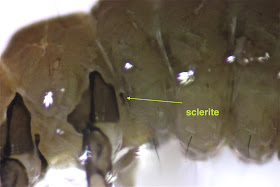I had no idea what to expect when I went to the Upper Doyles river this morning, but I ended up being very pleased with the results. While I still found the occasional Ephemerella dorothea spiny crawler, the find of the day was this new -- for me -- species, Drunella cornutella. The prominent tubercles on the leading edge of the robust fore-femora tell us the genus. For the species ID, we turn to Steven Beaty's "The Ephemeroptera of North Carlina," p. 25. There we read:
D. cornutella -- nymphs 6.4-8.5 mm; head smooth with moderately long lateral frontoclypeal projections but less than half as long as the distance between them; median ocellar tubercle blunt to moderately sharp; femora with dense row of long, fine setae on posterior margin; ratio of mesotibia to mesofemur < 0.85; abdomen without paired dorsal tubercles. Collected in spring through early summer. Common.
That's a lot to remember, so let's look at one thing at a time.
1) the long lateral frontoclypeal projections:
No question about that.
2) the median ocellar tubercle (bump) -- blunt":
Check.
3) "dense row of long, fine setae on posterior margin," of the femora, and "ratio of mesotibia to mesofemur < 0.85":
We can see the setae in this photo, and we can at least estimate the ratio of tibia to femur. I'd say that it is, indeed, less than 0.85. (I've now measured: the tibia is 1.1 mm, the femur is 1.8 mm, which gives a ratio of 6.1.)
4) no tubercles on the abdominal segments (they would project from the hind margins of the segments):
There you have it -- Drunella cornutella. North Carolina assigns of tolerance value of 0.0 to this spiny species. But before leaving the issue of species ID, let me note that D. cornutella can be confused with Drunella cornuta: they differ in only three ways. 1) D. cornuta nymphs range from 7.8 -- 11.4 mm in size, larger than D. cornutella: our nymph was not much more than 6 mm long. 2) The ocellar tubercle on D. cornuta is sharp, ours, as we've noted -- and illustrated -- is "blunt to moderately sharp." And 3) on D. cornuta nymphs the ratio of mesotibia to mesofemur is "> 0.85, usually closer to one." I'd say the nymph that I found this morning was definitely D. cornutella -- the tibia appears to be considerably shorter than the femur.
This means that we have now found three different species of the spiny crawler Drunella in local streams: D. tuberculata, D. walkeri, and D. cornutella. For the entries on D. walkeri and D. tuberculata -- both species found in the lower Doyles River and Buck Mt. Creek -- look back the entries posted on 4/9, 4/17, and 4/23.
________
In the leaf packs today, I continued to find lots of I. holochlora Perlodid stoneflies, while the flatheaded mayflies Epeorus vitreus and Epeorus pleuralis continue to crawl on the bottoms of rocks. But the tops of the rocks were covered with Glossossomatids (Saddle-case-maker caddisfly larvae). The Glossossomatid was, by far, the most common insect that I saw today, so I checked to see what Thomas Ames (Caddisflies: A Guide to Eastern Species for Fly Fishermen and Other Naturalists) had to say about when they're around. (As I've noted before, I primarily think of these cases as something we only see in the winter.) Well, it turns out that there can be two major hatches of Glossos, one in the spring and one in late summer (Ames, p. 94), so naturally, we'll be seeing the cases first in the winter and then in late spring.
I picked up three cases today, but by the time I got around to taking my photos, all three larvae were desperate to escape. (That's an I. holchlora Perlodid clinging to the side of the case.)
And before long, two of the larvae were out and curled up in the tray.
If you enlarge this photo (click on it), you'll be able to see one of the distinguishing features of this caddisfly larva: the anal prolegs are short and stubby. Actually, most of the proleg is fused with the final abdominal segment. This shows up well in this microscope photo, as does the characteristic "sclerite" on the dorsal side of segment 8.
The Glossossomatids we see in our streams are almost always Glossossomas (genus): there are no sclerites (dark marks) on the mesonotum. But I thought that today I'd see if I could key this one out to the level of species. It turned out to be easy. This is G. nigrior, which, Beaty notes, is the "only confirmed species in North Carolina" (Steven Beaty, "The Trichoptera of North Carolina," p. 7). Definition --
G. nigrior -- larvae 4-5 mm; pronotum with small black spot above forecoxae; small sclerites in intersegmental fold between thorax and first abdominal segment laterally.
Those features are pointed out in the following photos.
__________
Tomorrow, it's off to Buck Mt. Creek to see if there's any sign there of summer insects.
_________
More photos of Drunella cornutella.












No comments:
Post a Comment